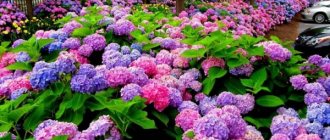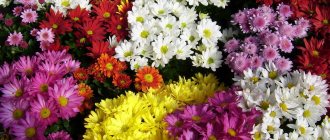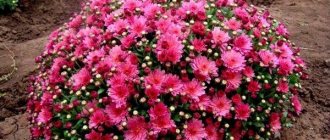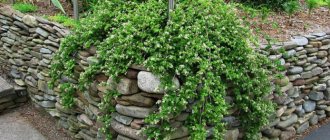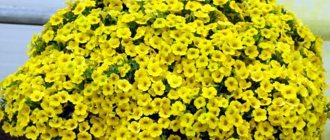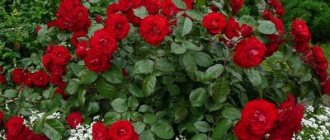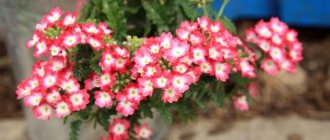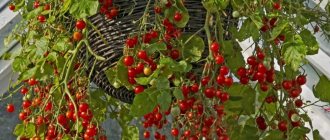Pelargonium
For vertical gardening, thyroid or ivy-leaved pelargonium with medium-sized white, pink, purple, crimson or red simple or double star-shaped flowers is often used. The plant takes root well in loamy soil in a sunny place, is resistant to cold weather, but does not tolerate even mild frosts. Pelargonium thyroid with complex fertilizers and water it with milk half diluted with water once a week. Ampelous pelargonium reacts to an excess of nitrogen fertilizers by increasing its green mass, but reducing the number of flower stalks.
Petunia cascade
The cascade subspecies has four features that distinguish it from others, including hanging varieties:
- The shoots are thicker. They are well-fed and durable, and do not break from gusts of wind.
- The growth of green mass occurs due to aerial shoots. They point up, but then begin to droop down.
- If Petunia Cascade was planted in a flower pot, it looks like a huge ball with loops.
- The cascade subspecies also has rather large buds, reaching 5 cm.
Petunia
Landing Features
As a rule, the plant is grown from seeds. Planting and care begin as early as February, although sowing can be carried out until April. The mixture is bought in a store or prepared independently from peat, sand, humus, and turf soil in equal quantities. Expanded clay is used as drainage.
- Distribute the seeds evenly.
- Lightly sprinkle with soil, crushing it in a sieve.
- Spray with water from a spray bottle and cover with glass.
- Place in a well-lit room with a temperature of 18 to 24 degrees.
Lilac petunia flowers
The first 2 weeks of supercascade red petunia and other varieties are watered daily. A couple of crystals of potassium permanganate are thrown into the water for irrigation to prevent diseases and accelerate growth. The emerging sprouts are gradually hardened and taken outside. When representatives of the Solanaceae family grow up, they are planted in containers with peat. Then they add fertilizer.
Popular varieties
For several years now, these plant varieties have been particularly popular among flower growers. What varieties are we talking about?
- Gioconda. The bush is small, but there are many branches. Medium size flowers. Well adapted to temperature changes.
- Ramblin'. It grows up to 40 cm, but the shoots stretch another meter. Refers to early varieties.
Petunia red
There is also a giant cascade petunia or Supercascade. We are talking about a variety series of large-flowered plants that form entire cascades of flowers up to 12 cm in diameter. Blooms early and abundantly. In our country, supercascade white, supercascade pink, and giant petunia are often planted in balcony boxes and hanging baskets.
Lobelia
Lobelia , which blooms profusely throughout the summer with blue, pink, white, lilac or red flowers, is gaining increasing popularity among hanging annuals The plant is quite whimsical and requires special attention during the period of growing seedlings. Lobelia seeds should be sown in early spring in small containers with moist, fertile soil, without sprinkling soil on top. Containers covered with glass or film should be left until germination in a bright room where the air temperature does not rise above 18°C. Ampelous lobelia can be placed in the garden in hanging containers or planted in open ground in a slightly shaded place in the second half of May, when the threat of frost is eliminated.
Kinds
There are annual and perennial hanging plants.
Ampelous unpretentious perennial flowers for the garden
In addition, they are divided into the following groups:
- curly - produce tendrils along which they rise upward;
- creeping - on the contrary, they send all their stems along the bottom. They are usually hung high;
- succulents can exist in arid climates, because they have cells that retain moisture for a long time;
- Decorative deciduous trees have a very beautiful leaf shape. They do not bloom, but attract with their decorative shape;
- those blooming luxuriantly captivate with their blooms. Such hanging annuals resemble a bright ball and bloom all season long. They are not even afraid of cold and drought.
To create an unusual flowering composition, a flowerpot is often used - a decorative flowerpot. It is easy and convenient to plant hanging flowers in it. Plants that trail downwards are suitable for pots. This will help create an unusual design that will decorate the upper rows of the balcony and terrace. Very often, flowering petunia is planted in flower pots. It has many advantages. Firstly, it blooms for a very long time: from early spring to late autumn. By the way, if you bring petunia into a house or apartment in the fall, it can delight you with its flowering in winter. Secondly, it has many shades. You can create an unusual composition from it. Thirdly, it is unpretentious in care, you just need to water it in a timely manner.
For your information! You can grow any plants in pots: from flowers to vegetables, such as tomatoes and cucumbers.
Many plants are suitable for hanging. For example: petunia, viola, geranium, begonia, bindweed, fuchsia and bacopa. You need to choose ones that are easy to care for. Ampel growing requires a lot from a plant. Roots in a pot heat up quickly, so for such planting you need to choose hybrids that can withstand drought.
Verbena
Ampel verbena has many advantages, among which the most important are abundant flowering, resistance to cold and heat, lack of special care requirements, and rapid growth. This herbaceous plant with branches more than 0.5 m long is capable of covering a vast surface in a short time. Verbena in open ground or in large hanging baskets will be a wonderful garden decoration. To avoid wasting time every spring sowing seedlings, plants in containers can be brought indoors for the winter and left in a bright, cool room.
What is Ampel?
Ampel plants or ampels are decorative representatives that are grown in hanging pots, baskets, and vases. The name “ampel” comes from the Latin word Ampella, which is translated into Russian as “small bottle”.
Ampelous flowers
Any flowerpot can be planted in pots or vases, but the best ones for ampels are those with climbing, creeping or falling shoots . Ampels can grow in an apartment, greenhouse or in the ground.
Dichondra
New for gardeners in the middle zone is dichondra ampelous, which looks beautiful on the facades of houses, hedges and any other vertical surfaces. This decorative leaf plant does not require special care, is resistant to pests and diseases and can be used to decorate gardens and interiors. The most popular variety is Silver Falls with silver-colored leaves. It is recommended to grow dichondra of this variety in a well-lit area. A creeping silvery dichondra resembling a dense mat with small lilac or white flowers.
The best flowers for flowerpots in the garden
All hanging ones are very beautiful and attractive, but still gardeners celebrate the best among the best. We indicate them in Table 4.
| Name | a brief description of |
| Lobelia | Herbaceous perennial. The inflorescences are small, but very bright and colorful: violet, purple, blue. Additionally, the buds are decorated with shiny, densely growing small leaves. |
| Nasturtium | Shoots can be weaving or erect. The colors of the inflorescences are red, yellow and bright orange. They bloom before the first frost. |
| Petunia | The most unpretentious of the hanging ones, it requires minimal care. Loves warmth and lots of light |
| Annual alyssum | Considered decorative. Literally covered with fragrant buds and resembles the shape of a ball. The stem is long and highly branched |
Although this is a matter of taste, some like representatives of the flora with lush and rich foliage, others like large, multi-colored buds, in fact, you can plant different varieties, giving a special zest to the design.
Fuchsia
The ampelous form of fuchsia appeared relatively recently and immediately won the love of gardeners due to its riot of flowering, rapid growth and unpretentious disposition. It is enough to place the container with fuchsia in an area protected from direct sunlight and not violate the basic rules of caring for the plant. The earthen ball in a flower pot should be moist at all times, but not over-moistened. Watering fuchsia should be combined with spraying, old bare branches should be cut off, and during the flowering period the plant should not be disturbed. Once every 2 weeks it is recommended to apply complex fertilizers under the flower.
How to make a composition of ampelous plants
To decorate a garden with flowers or add them to the landscape design of a site, you need excellent taste. Ampels can be combined not only by color, size or appearance; these plants complement interior and exterior items, combine them with ordinary garden trees and bushes, plant them not only in pots, but also on the roof or on an old stump, for example.
A few simple rules will help you correctly compose a flower arrangement:
- Plants without flowers can be supplemented with any ampels with inflorescences.
- If the composition is symmetrical, its creation begins from the center of the pot or flowerpot, planting the shortest flowers there. The sides of the container are decorated with varieties of flowing ampels, combining their color and shape.
- For a cascade composition, it is necessary to use several types of ampels with different stem heights. The tallest flowers are planted in the far row; as they approach the viewer, the height of the bushes should decrease so that the plants do not block each other.
- If there is an old well, an unnecessary cart, a chest of drawers or a bicycle on the site, they can be effectively enhanced with the help of hanging plants. Several pots with flowers planted in them are attached to these objects and the growth of stems is formed.
- A wooden or forged gazebo is simply created to be decorated with flowers. Here, ampels are hung at the entrance and near windows, pots of flowers are placed on window sills and tables, and corners are decorated with flowerpots with climbing plants (an excellent example of gazebo decor is shown in the photo below).
- An artificial pond or waterfall near the house will also not be complete without hanging flowers. Plants will add color to the pond, and the water, in turn, will provide the flowers with coolness.
- For climbing plants, arches are made of metal, wood or plastic. Such arches decorated with vines decorate the entrance to the courtyard or the path leading to the gazebo.
- Green tunnels made of flowers look especially impressive; a successful example of such an ensemble is shown in the photo.
- You can combine several types of one plant with each other, for example, regular and ampelous carnations.
- Identical plants with flowers of different shades look very impressive and bright. Most often, petunia bushes are combined in this way.
- Another win-win option is to decorate the area with pots of different flowers in the same color scheme. You can choose only plants with red inflorescences, or combine all shades of yellow in a flowerpot.
Advice! When composing a composition, you need to think not only about the beauty of the “bouquet”, but also about its “comfort”. The same soil, humidity and light levels must be suitable for all plants.
Bacopa
Bacopa ampelous, or sutera , a native of Central Africa and the Canary Islands, is rapidly gaining popularity among adherents of landscaping the facades of houses and balconies . A plant with flexible shoots about 50 cm long, densely covered with medium-sized white, pink or blue flowers, it is best kept in hanging containers. Bacopa is unpretentious, tolerates heat and direct sunlight well, blooms throughout the summer, but is afraid of overflow. In autumn, the plant should be brought into the house.
Hanging planters with these luxurious plants will transform the most boring gazebo, decorate the porch and transform the pergola!
Features of hanging plants and their classification
Depending on the method of growth, ampels are divided into several subspecies:
- creeping;
- climbing;
- curly;
- multi-socket.
Some of them look like vines, growing upward and having aerial roots. Others have many tendrils that help the plants cling to a mesh, arch or fence. Another group is cascading hanging plants for the garden. These are the ones that can be seen most often: gazebos, terraces and balconies are decorated with such pots.
Creeping ampels decorate horizontal surfaces. This is the so-called “rug”. This variety may have inflorescences or consist of only leaves. Creeping hanging plants decorate garden paths, zone space in the yard, and are used to complement flower arrangements.
Curling ampels decorate fences, metal and wooden arches. In order to rise up, these flowers need guides - stretched threads and ropes. With the help of climbing plants, they create “live” hedges, shade the sides of a gazebo or terrace, and decorate roofs.
Important! The main distinguishing feature of ampels is the flexible stem, thanks to which the flower can hang from a flowerpot or take on the bizarre shape of a braided object.
